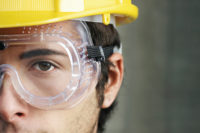Before lifting something off the ground, a written plan complying with B30.9 must be submitted to the general contractor (GC). Similarly with fall protection, a written plan complying with subpart R must be submitted to the GC. Iron workers live on the top of their world. A carefully developed fall protection plan helps keep them there.
A skeletal structure rises slowly from the ground. Beams are narrow limiting the working surface. Work is constantly at the top-most point meaning anchorages and tie offs are at a worker’s feet.
Paragraph 1926.760 establishes criteria for the following:
(1) Guardrail Systems
(2) Safety Net Systems
(3) Fall Restraint Systems (this article’s focus)
(4) Positioning Device Systems or
(5) Personal Fall Arrest Systems
When PERSONAL FALL ARREST SYSTEMS are employed, they must meet the following criteria:
a. The maximum arresting force on an employee must be limited to 900 pounds when using a body belt.
b. The maximum arresting force on an employee must be limited to 1800 pounds when using a harness.
c. The employee cannot free fall more than 6 feet, or contact any lower level.
d. The employee must be brought to a complete stop and the deceleration distance of travel must not exceed 3.5 feet.
e. The system must be strong enough to withstand twice the potential impact energy of an employee free falling 6 feet or the free fall distance allowed by the system, whichever is less.
The five commandments
Let’s examine each of these:
1. Recognize the Hazard.
2. Understand the manufacturer’s instructions.
3. Develop and record your company policy.
4. OSHA Regulations.
5. ANSI Standards
We’ll start with ANSI, which establishes a set of “best practices.” These are voluntary standards. OSHA may adopt ANSI standards by amendment, as a whole or in part.
OSHA
Any portion of an ANSI standard adopted by OSHA, by amendment, becomes a regulation and compliance is mandatory.
Company policy
At minimum, your internal regs must meet OSHA requirements. They may reflect ANSI standards, even if not adopted by OSHA, or be your own. Once adopted, you must comply.
Manufacturer’s instructions
If instructions claim to meet ANSI, the actual use of the product must also comply. Limits can be put on the use of a product – you must pay attention.
Recognize the hazard
Failure to recognize and deal with the hazard may result in prosecution for willful intent or manslaughter if a death occurs.
Look at criteria C and E above. Both reference a six-foot drop. Some time ago a GC sent this question to OSHA and received the accompanying interpretation:
Question: The provision in §1926.502(d)(16) requires that free fall distance be limited to 6 feet. It is impossible to design an attachment point that will allow me to limit the free fall to 6 feet. What are my obligations?
Answer: §1926.502(d)(16) also requires that the maximum arresting force be limited to 900 pounds when the personal fall arrest system incorporates a body belt and 1800 pounds when the system incorporates a body harness. If the employer has documentation to demonstrate that these maximum arresting forces are not exceeded and that the personal fall arrest system will operate properly, OSHA will not issue a citation for violation of the free fall distance.
How do you ensure via test data that the forces on the body will not exceed the limits established by
the standard, and that the personal fall arrest system will function properly?
Use tie offs at foot level or below. All anchorage points must be rated for 5,000 lbs. per person or a safety factor of 2. Remember fixed systems or catenary lines are like upside down two-legged bridles. Diagram 1 offers an off-the-shelf solution.
Thoughts and questions relating to this solution
• 3/8" galvanized cable has an M.B.L. (minimum break load) of approximately 14,000 lbs. So it’s good for two people right? Wrong. Example: In the mid-90s My Wire Rope Company sold a trailer manufacturer 100 ft. of 3/8” cable with a large turn buckle at one end. Unfortunately my order desk didn’t ask enough questions on what the application was. They strung it above the trailers and tightened it tight enough to play a song on it. They dropped a pulley on the cable and hooked a retractable to it; the employee could go along the top of the trailer stapling the roof. When the supervisor wasn’t looking, one of the employees decided to use it as a zip line and run off the back of the trailer to see how far he could go down the line. Another employee would pick him up with a boom truck when he stopped. The cable snapped on the first try, resulting in a few broken bones. Engineers use some of these factors when calculating deflection under load (Diagram 3).
• Load: Only a few retractables are on the market designed for foot level drops and even fewer designed for below the feet drops. The unit engineered into the system above has a mechanical shock absorber with a disk brake mechanism designed for free falls up to 78" when tied to a rigid tie-off point, keeping the impact to the body under 900 lbs. Another benefit of the acceptable retractable: the line is under tension during the drop. The web or wire coils back into the unit and then the disk brake kicks in for a soft drop with less chance of lower level contact. Plus, when dropping on a catenary line (not a rigid tie-off point) there is shock absorber capability in the line itself. This lessens the impact to the line and increases the safety factor.
• Does where the drop occurs on the line affect the angle of deflection, adding greater or less stress on either anchorage point?
Yes and no. Some engineers theorize that this would be a factor. Other theorize that since the catenary line has sag and deflection, the blow on the cable is a glancing hit and the hook slides a little bit, if it’s the same amount of energy over a longer period of time. The peak load is less. It’s very similar to when an employee falls head first. Many times the shock pack will not deploy all the way because it takes time to bring the employee into an upright position (Diagram 2). In doing the physical test, the latter proves to be true. The middle of the span is worst-case scenario.
• In temporary lifeline systems, is a thimble eye mandatory?
Not if the engineer’s design will allow it. According to the wire rope Technical Board D/d ratio on 3/8" cable with a 3/8" pin there is a 50% reduction. But since the eye is twice as strong as the body in a pull test, the cable always breaks at the weakest link behind the last D.F. clip. Note: Rule of thumb for added safety factor always go one size up on the shackle.
• Are round rings mandatory on horizontal systems?
Not if the engineer’s design allows it and the components are compatible. Fixed horizontal lifeline systems have sag in the line and often the rings settle in the middle of the system, creating a hazard for the employee to connect safely. Plus if it’s a two- or four-man system, it makes it impossible for the employees to pass by one another.




